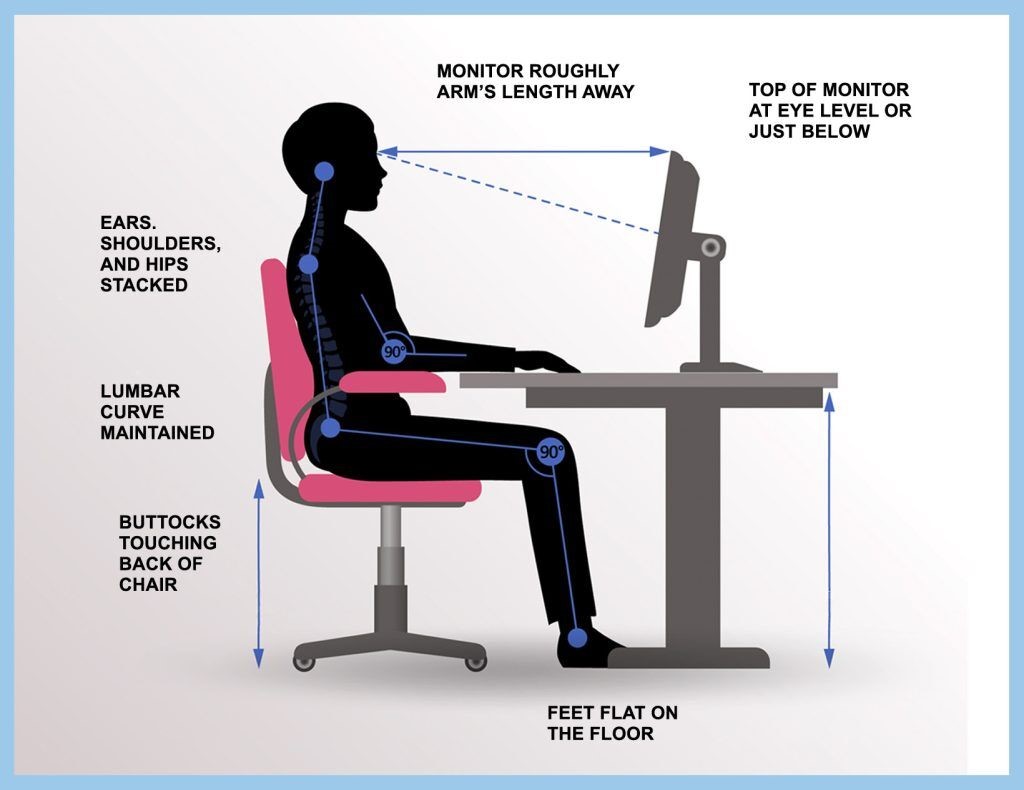Office workers and some other employees report suffering from back and neck pain associated with poor posture. Crucially – studies have shown that proper sitting posture at a computer is essential for dealing with stress. Focusing on correct sitting posture is more than just a battle against slouching. It translates to:
· Better longevity.
· Increased productivity.
· More confident body language and stronger personal brand.
Read on to uncover how best to support your neck and spine health; We bet you’re sitting up straight already!
What is the proper sitting posture?
Our understanding of proper sitting posture has improved drastically in recent years, thanks to studies in workplace ergonomics. Ensure the correct sitting position by studying the diagram and following the 10 guidelines below:
- Keep your ears, shoulders and hips “stacked” (aligned in the vertical plane).
- Ensure the monitor or computer screen is positioned at eye level, or slightly below eye level. Use a monitor arm if necessary.
- Use lumbar support to maintain your lower back’s natural curve.
- Don’t lean to one side. Distribute your weight across both hips.
- Check that your head isn’t protruding forward.
- Maintain at least 5 centimetres between the back of your knees and the edge of the chair.
- Ensure your knees are at the same height as your hips or slightly lower.
- Ensure that your ankles are in front of your knees.
- Check that your elbows are at your sides. Don’t flare them!
- Leave 10-15 centimetres between the edge of your desk and keyboard to create space for your wrists.
Tips to ensure correct sitting posture.
The correct sitting position is a product of your wider environment and lifestyle habits. Pay attention to the following for extra improvements in your sitting position:
Upgrade your chair: buy the best ergonomic chair you can afford (how much to spend?)
- Stand up: invest in a standing desk – this is the best way to avoid sitting for prolonged periods every day.
- Shapeshift: Alternate between upright (tasking) and reclined positions in your office chair. You can do every hour (set a reminder!).
- Relax your shoulders: Know the difference between a relaxed position and slouching – every few hours, roll your shoulders back and pull your shoulder blades together.
- Hydrate: Drink 2-4 litres of water to support muscles and ward off fatigue.
- Promote circulation: Avoid sitting with crossed legs, which can restrict blood flow and lead to slouching.
- Take screen breaks: Shift your gaze to the furthest item away in your surroundings every hour (set a reminder on your phone).
- Motion is lotion. Incorporate movement into your workday with simple exercises you can do at your desk.
What are the adverse effects of bad posture?
We all know how it feels to be stiff, sore and battling against habitual poor posture.
Poor sitting posture can impact mental and physical well-being and lead to Repetitive Strain Injury (RSI).
RSI occurs through repetitive and uncomfortable movements – often typing.
Without our screens at a perfect height, our necks also bear additional weight (up to 30kg!), our shoulders can start to slouch, and our hands and wrists overwork to balance the alignment.
Being unaware of correct posture can lead to the following:
· Neck and back pain.
· Mental and physical fatigue.
· Headaches or migraines.
· Muscle tension.
· Tendonitis.
· Carpal tunnel syndrome.
· Rounded shoulders.
· Poor spine alignment.
· Breathing problems.
· Mood swings.
Although it takes time and conscious effort, reversing these effects is possible if you actively and consistently work towards a mindful posture.
Above: Studies show that prolonged sitting leads to chronic health issues. Reduce risks by interrupting prolonged periods with standing and walking.
What does good posture lead to?
Studies have shown that the correct sitting posture can improve self-confidence and a positive self-image.
There are a host of physical benefits too:
· Improved mood and well-being.
· Less tension in the shoulders and neck.
· Fewer aches from slouching.
· Fewer headaches.
· Increased self-esteem.
· Easier time breathing.
· More energy!
Bottom line about sitting posture at a computer.
Ensuring that you sit with proper posture at a computer workstation can significantly improve your physical, mental, and emotional well-being.
I encourage you to make small, mindful choices to support your body. These tiny changes will lead to large increases in efficiency, productivity and comfort in the workplace.
As a bonus, by modelling your care for yourself to others, you will create a more sustainable and positive work environment for those around you.
